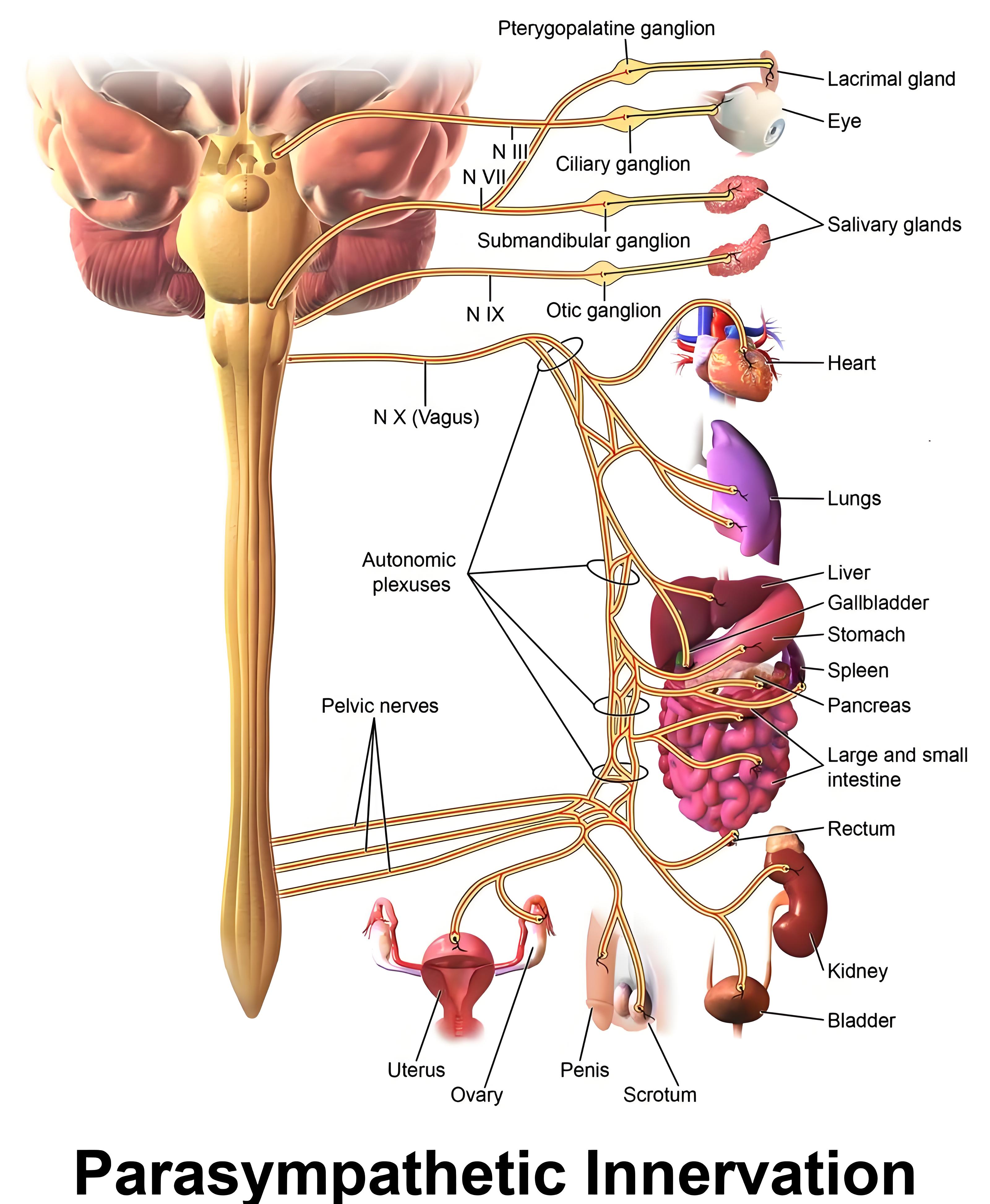Understanding the Vagus Nerve and Somatic Symptoms
If you are troubled by symptoms such as insomnia, fatigue, numbness, back pain, brain fog, gastrointestinal pain, reduced olfaction, swallowing difficulties, emotional numbness, or physiological hoarseness, it is essential to understand the vagus nerve. The connection between the body and mind is inseparable, and seemingly inexplicable somatic symptoms may be a cry for help from the vagus nerve under chronic stress.
What is the Vagus Nerve?
The vagus nerve is the longest and most widely distributed pair of cranial nerves in the body, containing sensory, motor, and parasympathetic nerve fibers. It extends to various organs within us, creating a bidirectional communication network between the brainstem and organs.
Understanding the functional status of the vagus nerve is a crucial avenue for comprehending the physiological foundations of psychosomatic diseases.
The Biological Basis of Mental Disorders
It is crucial to highlight a significant consensus within the scientific community: conditions such as borderline personality disorder, schizophrenia, depression, anxiety disorders, and autism undoubtedly possess deep and complex biological bases. These conditions are not merely psychological defects or weaknesses of will.
However, prior to the emergence of the Polyvagal Theory, there had been few theories that provided a clear physiological explanation for the behavioral shutdown observed in depression (such as psychomotor retardation, emotional numbness, and social withdrawal) from the evolutionary perspective of the autonomic nervous system.
Polyvagal Theory: A Revolutionary Approach
Dr. Stephen Porges proposed the Polyvagal Theory in the 1990s, suggesting that the autonomic nervous system has undergone three evolutionary phases, mirroring the evolutionary history of life on Earth from primitive vertebrates to vertebrates and ultimately mammals.
1. **Dorsal Vagus (Primitive Vertebrates)**: Responsible for freezing responses. For instance, lizards freeze in place when threatened, utilizing camouflage.
2. **Sympathetic Nervous System (Vertebrates)**: Governs fight-or-flight responses. Animals like deer escape rapidly from predators, whereas crocodiles may attack fiercely when threatened.
3. **Ventral Vagus (Mammals)**: Governs social behavior, enabling dogs to express friendliness and seek comfort in safe environments.
This model is sophisticated because these three systems do not operate independently; instead, they form a response sequence with clear priorities. The most advanced system (ventral vagus) is the body’s preferred operating mode. When it is activated and functioning effectively, it creates a safe physiological state, keeping the older responses (fight or flight and freezing) deactivated.
The Vagus Nerve: A Two-Way Highway Within the Body
The vagus nerve resembles a vast network, connecting the brain to almost all major internal organs like the heart, lungs, and gastrointestinal tract. We can visualize it as a two-way highway:
– **Downward Lane**: Commands from the brain to organs (e.g., slowing the heartbeat).
– **Upward Lane**: Organs report back to the brain in real-time (e.g., signaling inflammation in the gut).
Notably, over 80% of the traffic on this highway is upward, indicating that bodily sensations significantly influence brain states and emotions.
Three Modes of the Polyvagal Theory
The Polyvagal Theory presents a “three-color traffic light” system, where the body automatically shifts response modes based on perceived safety.
🟢 **Green Light: Safety and Social Mode** (Ventral Vagus Dominant) – This is our ideal state, where the most advanced branch of the vagus nerve operates. It fosters feelings of safety, relaxation, and curiosity, allowing for seamless social connections.
🟡 **Yellow Light: Fight or Flight Mode** (Sympathetic Nervous System Dominant) – When sensing stress or danger, the body enters a heightened alert state, crucial for short-term survival. However, prolonged yellow light can lead to chronic fatigue and burnout.
🔴 **Red Light: Freezing or Shutdown Mode** (Dorsal Vagus Dominant) – This is activated during overwhelming threats, causing emotional numbing, despair, and extreme fatigue. The body goes into a “play dead” mode, drastically slowing heart rate and metabolism.
Body’s Alarm Signals
Dysfunction of the vagus nerve may lead to symptoms such as depression, fatigue, insomnia, inflammation, altered appetite, and various somatic symptoms mentioned earlier.
How to Restart the Vagus Nerve
To retrain the vagus nerve effectively, consistency in practice is key. Methods to engage the vagus nerve include:
1. **Diaphragmatic Breathing**: Focus on abdominal breathing, inhaling and feeling the abdomen expand, while exhaling slowly to stimulate the vagus nerve.
2. **Vocal Vibrations**: Singing, humming, or gargling, which stimulates the vagus nerve in the throat.
3. **Genuine Social Interaction**: Spending time with loved ones and sharing experiences enhances the green light mode.
4. **Rhythmic Gentle Movement**: Engaging in activities like yoga or tai chi that emphasize bodily awareness and rhythmic patterns can effectively regulate the nervous system.
Professional Interventions: Reshaping the Brain
Effective psychological counseling can modulate emotional tension and reduce physical symptoms. However, improper interventions can exacerbate symptoms, highlighting the need to select therapists carefully.
Mindfulness and meditation can also promote brain reshaping, offering various techniques to choose from.
Understanding the Source of Somatic Symptoms
Many somatic symptoms, such as heart palpitations, chest tightness, gastrointestinal discomfort, fatigue, and numbing sensations, signify autonomic nervous system dysregulation.
Emotional Release through Counseling
A crucial reason for somatic symptoms is that unexpressed or excessively intense emotions can become stored in the body. Effective counseling provides a safe space for these energies to be felt and released naturally, alleviating long-term discomfort.
Conclusion: The Intersection of Vagus Nerve and Traditional Chinese Medicine
While the vagus nerve is a precise anatomical structure under Western medicine, meridians in traditional Chinese medicine represent channels for qi and blood flow. Both share functional overlaps and intersecting pathways, although they are not identical.
